If you’re searching for fast, effective migraine relief, you’re in the right place. We understand the debilitating nature of severe migraines and how they can disrupt your life – which is why we’re exploring this powerful treatment option that’s helping thousands find relief when other methods fall short.
IV therapy for migraine is a medical treatment that delivers medications and fluids directly into the bloodstream through an intravenous line to rapidly relieve severe headache pain and associated symptoms. This specialized infusion approach bypasses the digestive system, allowing for faster medication absorption and more effective symptom relief compared to traditional oral medications.
According to the Cleveland Clinic (2019), their infusion therapy program treated 526 headache patients with 1,676 infusion treatments, achieving clinically meaningful improvement in 40% of patients for headache symptoms and over 50% for dizziness relief. In a groundbreaking study published in JAMA (2021), treatment with eptinezumab during a migraine attack resulted in median time to headache pain freedom of just 4 hours compared to 9 hours with placebo.
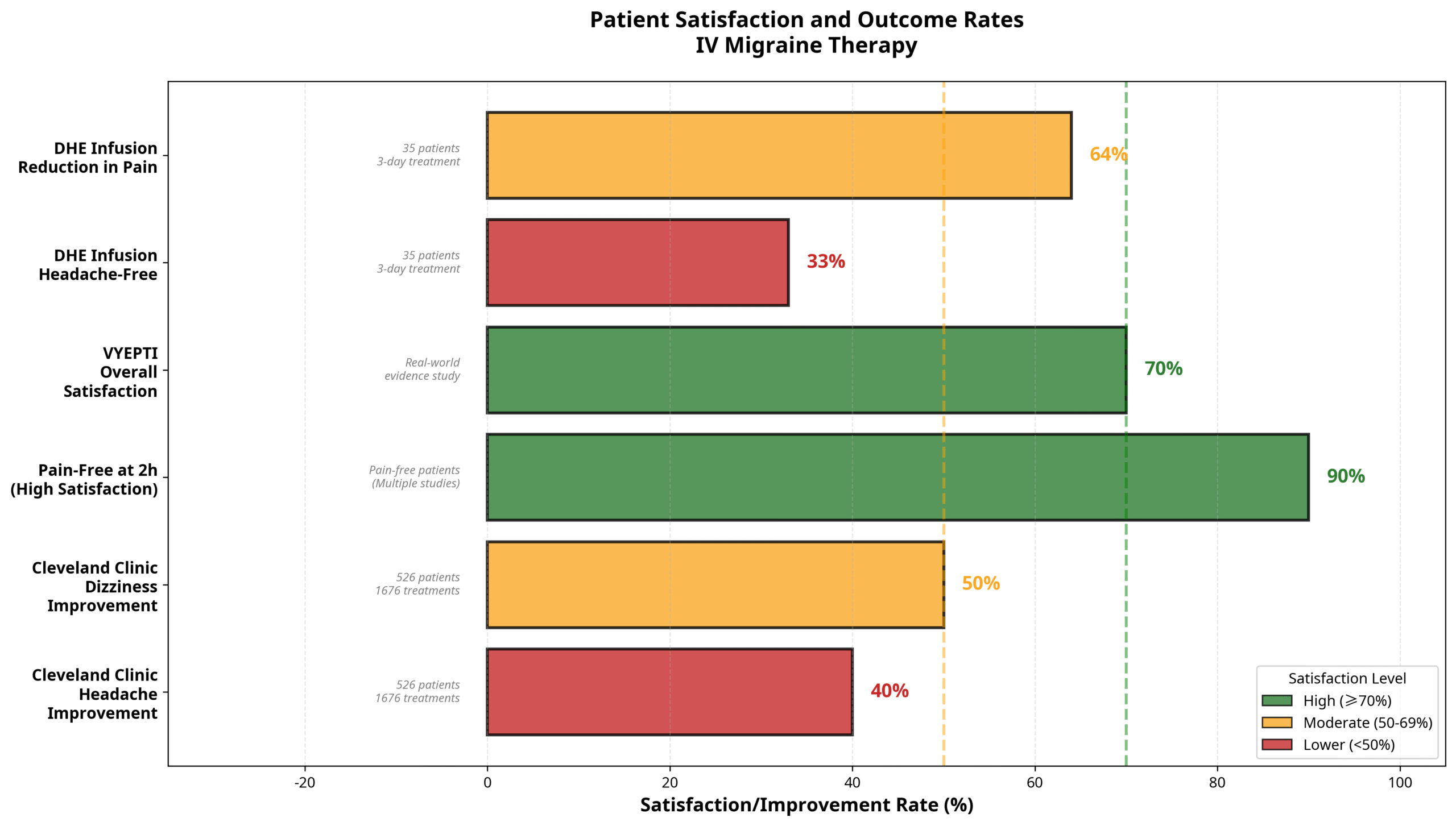
“IV headache infusion treatments have been shown to remain effective for as long as one month after treatment,” notes Complete Neurological Care (2016), highlighting the lasting impact of this therapy beyond immediate relief.
Key Takeaways:
• IV therapy delivers rapid migraine relief through direct bloodstream medication delivery, with most patients experiencing improvement within 15-45 minutes
• Common IV cocktails include magnesium sulfate, ketorolac, metoclopramide, and specialized formulations tailored to individual needs
• Clinical studies show 74-83% effectiveness rates, with some treatments providing relief lasting up to one month
• Treatment costs range from $200-350 per session, with insurance coverage available for certain FDA-approved options
• Ideal candidates include those with severe, treatment-resistant migraines, though medical evaluation is essential to rule out contraindications
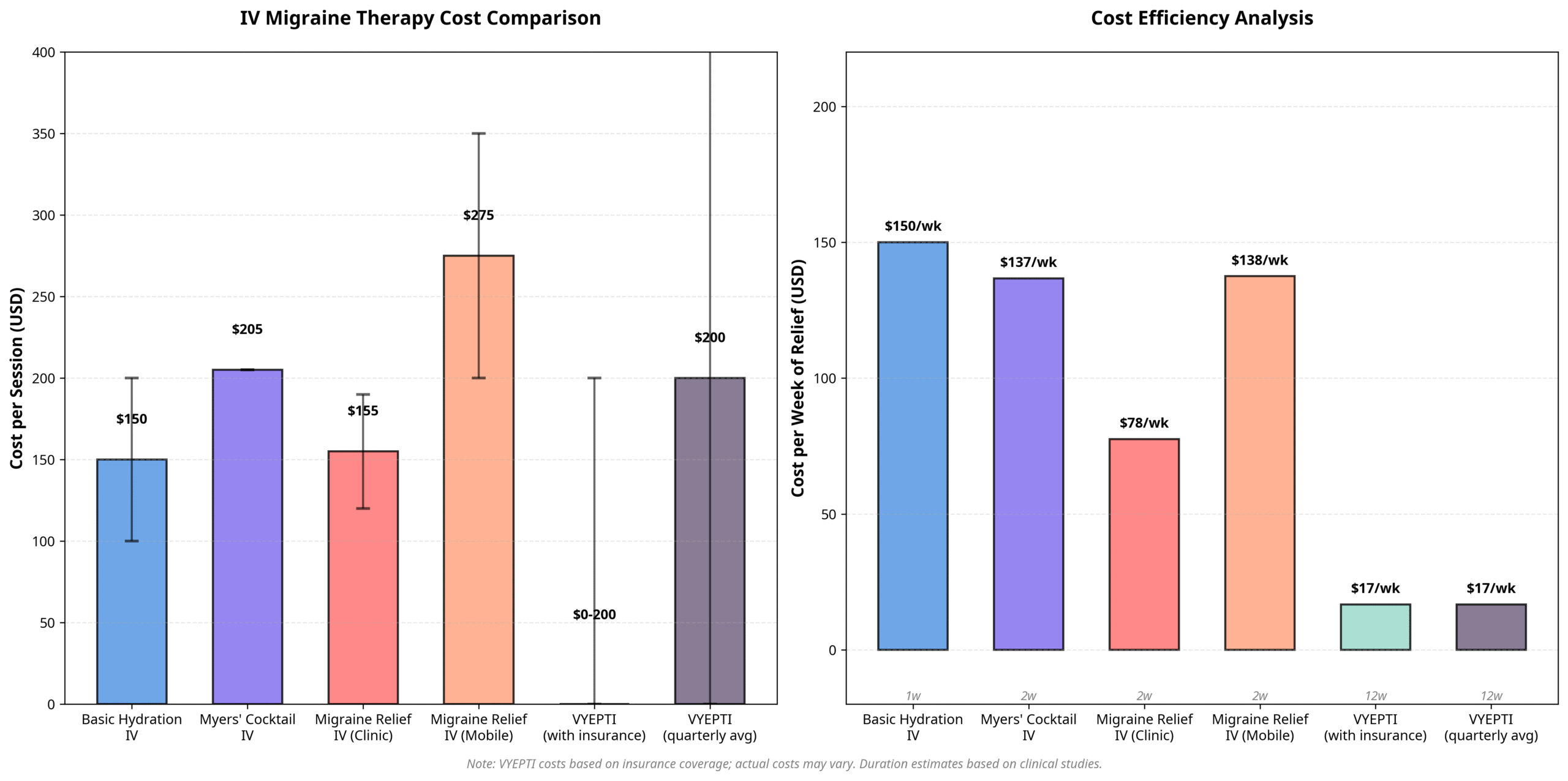
Article Overview: This comprehensive guide explores how IV therapy works at the biological level, identifies who makes an ideal candidate, walks through the treatment process step-by-step, examines benefits versus risks, compares IV therapy to alternative treatments, and reviews typical patient outcomes – all while introducing how The Drip IV Infusion can customize treatments for your specific migraine needs.
Practical Tip: Schedule your IV therapy session at the first sign of a severe migraine rather than waiting for peak pain intensity – early intervention dramatically improves treatment effectiveness and can prevent the attack from reaching its full severity.
As we explore the science behind IV therapy for migraines, you’ll discover why this treatment has become a game-changer for those seeking fast, effective relief from debilitating headache pain.
How Does IV Therapy Help Relieve Migraine Symptoms?
IV therapy relieves migraine symptoms through direct bloodstream delivery of medications and nutrients that bypass digestive absorption delays. The treatment combines hydration, anti-inflammatory agents, and essential minerals to target multiple migraine pathways simultaneously. Hospital protocols demonstrate 74-78% headache relief within 2 hours, while specialized formulations address pain, nausea, and inflammation concurrently.
What Ingredients Are Commonly Used in IV Migraine Therapy?
The ingredients commonly used in IV migraine therapy include magnesium sulfate, ketorolac, metoclopramide, and hydration solutions. Standard hospital protocol combines 1 liter of normal saline, 30 mg of ketorolac for inflammation, and 10 mg of prochlorperazine for nausea. Cleveland Clinic recommends 1-2 liters of normal saline (0.9% NaCl) infused over 2-4 hours.
| Solution | Clinical Detail | Typical Administration / Range |
| Magnesium sulfate | Dosage | 1-2 grams IV |
| Ketorolac | Standard dose | 15-30 mg |
| Metoclopramide | Typical dose | 10 mg |
| Normal saline | Volume | 1-2 liters |
| B-complex vitamins | Components | B2, B6, B12 |
| Dexamethasone | Use | Anti-inflammatory |
Wellness IV formulations expand beyond hospital protocols with B-complex, glutathione, vitamin C, GABA, anti-nausea medications, and Benadryl. Inpatient protocols for status migrainosus typically use 1 liter IVF, 2 grams IV magnesium sulfate, and 15 mg ketorolac.
How Quickly Can Patients Expect Relief from Migraine After IV Therapy?
Patients can expect relief from migraine after IV therapy within 15-45 minutes of infusion start. IV metoclopramide demonstrates 83% effectiveness at 1 hour in randomized, double-blind placebo-controlled trials. The IV/IM metoclopramide route proves effective in 67-88% of cases at 30-60 minutes.
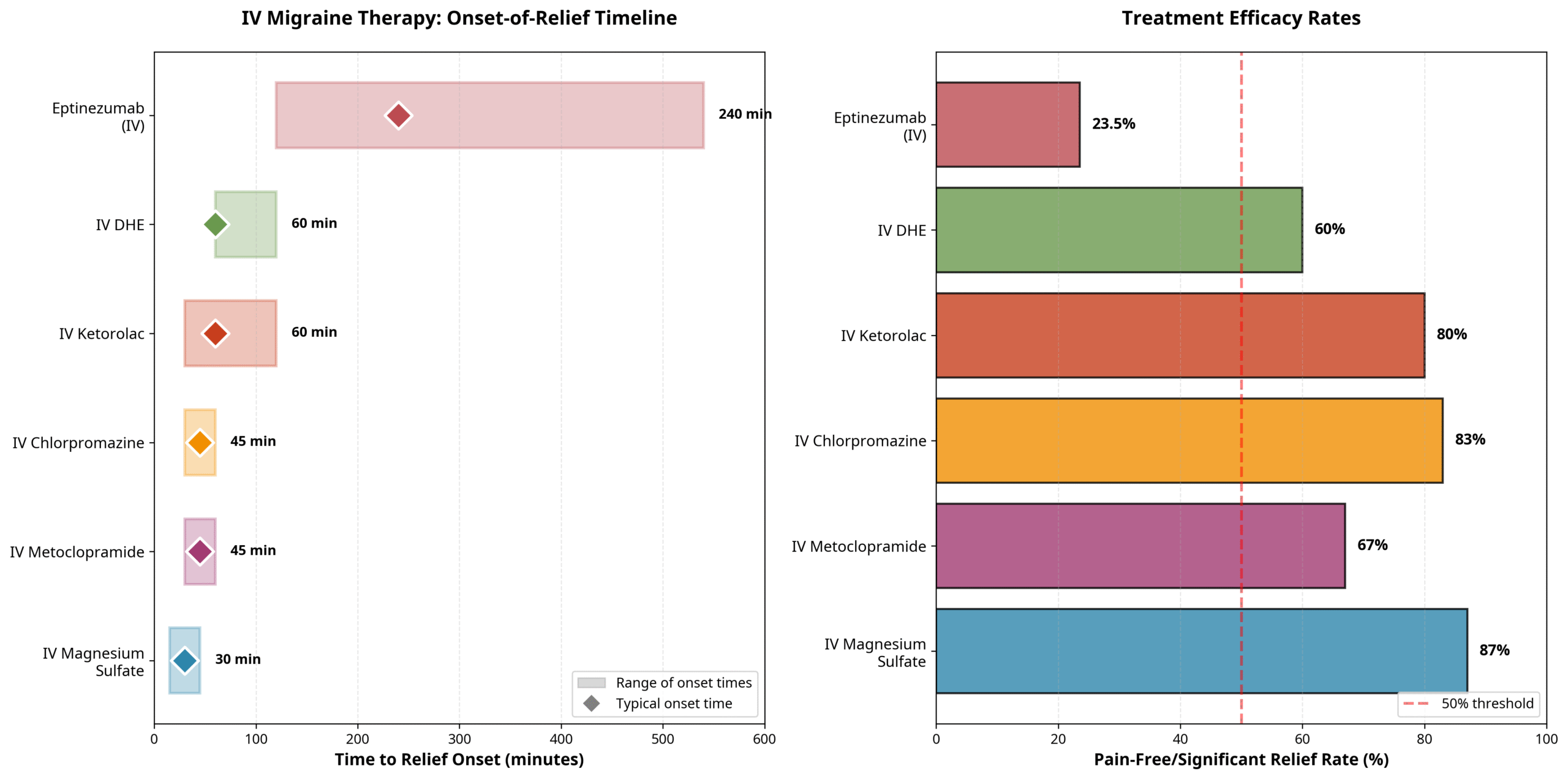
Eptinezumab treatment achieves median time to headache pain freedom in 4 hours versus 9 hours with placebo. On day 1 after eptinezumab administration, 28.6% of treated patients reported migraine headaches compared with 42.3% of placebo-treated patients. The median time to absence of most bothersome symptom reaches 2 hours with eptinezumab versus 3 hours with placebo (Hazard ratio: 1.75, P < .001).
What Are the Biological Mechanisms Behind IV Therapy’s Effectiveness for Migraines?
The biological mechanisms behind IV therapy’s effectiveness for migraines involve magnesium’s role in neurotransmitter regulation and vascular tone control. A clinical trial of 1g intravenous magnesium sulfate given over 15 minutes showed pain disappeared in 86.6% of patients and diminished in 13.4% in the treatment group. Magnesium acts as an efficient, safe, and well-tolerated drug in migraine attack treatment.
IV therapy achieves headache relief within 2 hours in 74% of low-dose and 78% of high-dose participants in clinical trials. The direct bloodstream delivery bypasses gastrointestinal absorption barriers, allowing rapid therapeutic concentrations. IV headache infusion treatments maintain effectiveness for up to one month after treatment, suggesting sustained neurological and vascular modulation beyond immediate symptom relief.
Who Is an Ideal Candidate for IV Therapy for Migraine?
An ideal candidate for IV therapy for migraine is someone experiencing severe or frequent migraines who hasn’t found adequate relief from oral medications. Patients with chronic migraines using prescription medications 10 or more days per month, those with migraine with aura, and individuals experiencing status migrainosus show particularly strong responses to IV treatments. The upcoming sections detail specific migraine types and medical considerations.
Are There Specific Types of Migraine That Respond Best to IV Therapy?
Specific types of migraine that respond best to IV therapy include migraine with aura, chronic migraine, and intractable headaches. A 2021 clinical study found intravenous magnesium sulfate (1 to 2 g) particularly effective for migraine with aura. Patients with chronic migraine achieved a 75% reduction in migraine days with VYEPTI treatment according to manufacturer data. Before starting eptinezumab treatment, 81% of patients (75/93) reported using prescription acute medication 10 or more days monthly, indicating medication overuse patterns. A 2019 retrospective analysis showed IV propofol achieved a 95.4% success rate in abolishing intractable headaches.
Key responsive migraine types:
- Migraine with aura (responds to IV magnesium)
- Chronic migraine (15+ headache days monthly)
- Status migrainosus (lasting 72+ hours)
- Medication overuse headaches
These specific migraine patterns show higher response rates because IV therapy bypasses gastrointestinal absorption issues common during severe attacks.
What Medical Conditions or Medications Should Be Considered Before IV Therapy?
Medical conditions or medications that should be considered before IV therapy include cardiovascular disease, uncontrolled hypertension, and current triptan use. According to 2022 FDA guidelines, triptans are contraindicated in hemiplegic or basilar migraine and patients with hepatic impairment. Patients with vascular disease, uncontrolled hypertension, or hemiplegic migraine should avoid triptans before IV therapy. Additional contraindications include cerebrovascular disease, ischemic bowel, and migraine with aura when considering triptan-based protocols.
Critical contraindications requiring specialist consultation:
- Cardiovascular or cerebrovascular disease
- Uncontrolled hypertension
- Hemiplegic or basilar migraine
- Hepatic impairment
- Ischemic bowel disease
DHE (dihydroergotamine) carries specific risks including cerebral ischemia, potentially causing confusion and headache according to manufacturer warnings. The American Headache Society recommends IV dihydroergotamine administration only after consultation with a neurologist or headache specialist. Understanding these medical considerations ensures safe IV therapy selection for migraine patients seeking treatment through services like The Drip IV Infusion.
What Is the Typical Process for Receiving IV Therapy for Migraines?
The typical process for receiving IV therapy for migraines begins with medical evaluation, followed by IV insertion and medication administration over 30-60 minutes, with most patients experiencing relief within this timeframe. Cleveland Clinic Infusion Therapy treated 526 headache patients with 1,676 infusion treatments, demonstrating the established nature of this treatment approach.
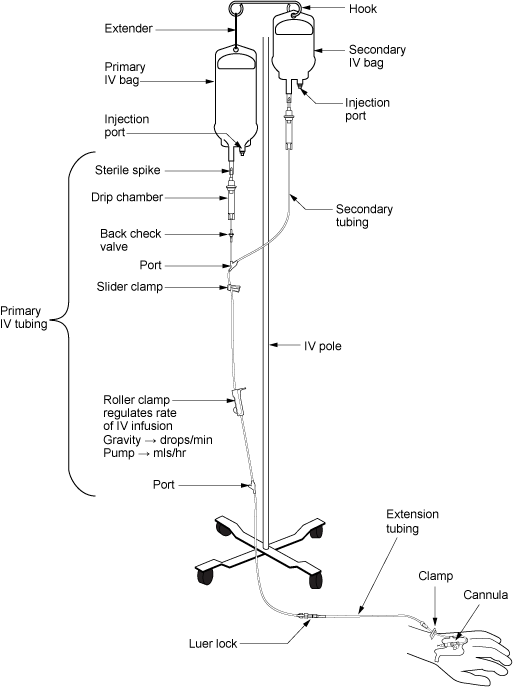
What Can Patients Expect During an IV Therapy Session?
Patients can expect a structured treatment session lasting 30-90 minutes in a comfortable clinical setting. According to Cleveland Clinic data, pretreatment pain ratings showed 1,096 ratings of 4 or higher on a 0-10 scale. The IV insertion process takes 5-10 minutes, followed by medication infusion through normal saline solution.
During treatment, 40% of patients reported improved headache after infusion therapy. More than 50% of patients reported improved dizziness scores following treatment. Medical staff monitor vital signs throughout the session, checking blood pressure, heart rate, and oxygen levels every 15-30 minutes.
The infusion environment typically includes reclining chairs, dimmed lighting, and quiet spaces to minimize sensory triggers. Patients remain awake and can use phones or read during treatment. Some facilities offer blankets and eye masks for comfort.
How Should Patients Prepare for an IV Migraine Treatment?
Patients should arrive hydrated by drinking 16-24 ounces of water 2-3 hours before treatment. Wear comfortable, loose-fitting clothing with sleeves that roll up easily for IV access. Bring a current medication list including all prescription drugs, supplements, and recent migraine treatments.
Avoid caffeine 4-6 hours before treatment to prevent interference with certain medications. Eat a light meal 1-2 hours prior to prevent nausea during infusion. Arrange transportation home, as some IV medications cause drowsiness or dizziness lasting 2-4 hours post-treatment.
Inform providers about allergies to medications such as NSAIDs, steroids, or anti-nausea drugs. Report pregnancy, breastfeeding, or chronic conditions like kidney disease or hypertension. Document migraine frequency, triggers, and previous treatment responses for optimal medication selection.
This systematic approach to IV migraine therapy ensures safe, effective treatment delivery while maximizing patient comfort and therapeutic outcomes.
What Are the Benefits and Risks of IV Therapy for Migraine?
The benefits and risks of IV therapy for migraine involve rapid symptom relief balanced against potential side effects. IV therapy delivers medications directly into the bloodstream, bypassing digestive absorption barriers that limit oral treatments.
What Are the Potential Side Effects and Complications of IV Therapy?
The potential side effects and complications of IV therapy vary by medication type and patient sensitivity. VYEPTI causes stuffy nose and scratchy throat as the most common reactions. DHE produces nausea or vomiting in some patients. Ketorolac leads to headaches, dizziness, drowsiness, nausea, and constipation.
Immunoglobulin therapy creates mild effects such as light headache, fever, chills, and fatigue. Severe reactions include skin reactions and acute renal failure. Rare but serious complications encompass chest pain, irregular heartbeat, breathing difficulties, facial swelling, severe allergic rash, and itching.
A 2020 clinical trial on magnesium sulfate found mild side effects in 26 patients (86.6%) that did not require treatment discontinuation. Additional risks include medication overuse headaches, caffeine-related sleeplessness, stomach upset, and abdominal pain.
Most side effects resolve quickly after treatment ends. Patients with severe reactions require immediate medical attention.
How Do the Benefits of IV Therapy Compare to Oral Migraine Treatments?
The benefits of IV therapy compare favorably to oral migraine treatments in speed, satisfaction, and duration. Over 90% of patients achieving pain freedom at 2 hours report satisfaction with IV treatment. Less than 10% of patients with moderate or severe pain express satisfaction with oral medications alone.
IV treatments provide extended relief lasting up to one month after administration. A 2022 VYEPTI study revealed more than 70% of patients experienced overall migraine improvement over 2 years. Nearly 60% felt more engaged in life with VYEPTI treatment.
IV therapy bypasses gastrointestinal absorption issues that reduce oral medication effectiveness. Direct bloodstream delivery achieves therapeutic levels faster than pills or tablets. Patients with nausea benefit particularly from IV administration when oral medications prove difficult to tolerate.
The combination of rapid onset, high satisfaction rates, and lasting effects positions IV therapy as a superior option for severe or treatment-resistant migraines compared to traditional oral approaches.
How Does IV Therapy for Migraine Compare to Other Migraine Treatments?
IV therapy for migraine compares to other treatments through distinct mechanisms of action, combination protocols, and cost-accessibility factors. Direct intravenous delivery bypasses digestive absorption limitations while enabling simultaneous administration of multiple therapeutic agents. Treatment comparisons reveal varying efficacy rates, onset times, and duration of benefits across modalities.
Can IV Therapy Be Used Alongside Other Migraine Medications?
IV therapy can be used alongside other migraine medications according to established clinical protocols. The European Federation of Neurological Societies (EFNS) migraine treatment guideline recommends corticosteroids for status migrainosus management. DHE frequently improves headache frequency and severity when combined with protocols to minimize medication overuse headache.
Clinical evidence shows mixed results for combination approaches. A study on intravenous fluid administration found no improvement in pain outcomes among patients with acute migraine who received concurrent intravenous metoclopramide treatment. Evidence-based practice advisories provide foundational steps toward standardizing inpatient headache care protocols.
Combination therapy protocols include sequential administration, concurrent delivery, and bridging strategies. Healthcare providers coordinate IV therapy with oral preventives, rescue medications, and neuromodulation devices. Treatment plans integrate acute interventions with long-term prevention strategies.
How Does the Cost and Accessibility of IV Therapy Stack Up Against Alternatives?
The cost and accessibility of IV therapy varies significantly based on treatment location and formulation type. Mobile IV therapy base packages start at $199, while Myers’ Cocktail costs $205. Clinic-based migraine IV therapy ranges from $120 for members to $190 for walk-in patients.
Session pricing spans broad ranges across providers. IV therapy for migraine typically costs between $200-$350 per standard session. Specialized drips range from $200 to $500 per session. Treatment costs vary from $80 to $999 depending on specific formulation and provider type.
| Treatment Type | Price Range | Duration/Frequency |
| Mobile IV therapy | $199+ base | Single session |
| Myers’ Cocktail | $205 | Single session |
| Clinic-based | $120-$190 | Per session |
| Home IV drip | $115-$749 | Per session |
| VYEPTI | $0* with insurance | Every 3 months |
*Commercial insurance patients may qualify for $0 copay per infusion including up to $200 in administration fees.
IV therapy costs $125-$375 per session with effects lasting 1-2 weeks. Home service pricing typically ranges from $115 to $749 per session based on treatment complexity and location.
Understanding these cost comparisons helps patients evaluate IV therapy against oral medications, injectable preventives, and device-based treatments when planning migraine management strategies with their healthcare providers.
What Results and Outcomes Do Patients Typically Experience with IV Therapy for Migraine?
Patients typically experience significant relief from IV therapy for migraine, with outcomes varying based on the specific treatment protocol and individual response patterns. Clinical evidence demonstrates that IV therapy produces both immediate symptom relief and sustained improvements in migraine frequency and severity.
The following subsections explore the treatment frequency required for optimal results and the duration of therapeutic benefits.
How Many Sessions Are Usually Needed for Noticeable Improvement?
The number of IV therapy sessions needed for noticeable improvement depends on the treatment type and individual response. Preventive infusions like VYEPTI follow a quarterly pattern, requiring administration once every 3 months. Some patients achieve optimal results with monthly preventive treatments.
A 5-day DHE infusion protocol produces improvement in headache and disability in patients with migraine. In a study of 35 patients receiving DHE infusions, 33% became headache-free and 64% experienced headache reduction by the end of 3 days. Valproate infusion showed that 5 out of 13 patients (38%) reported improvement in headache intensity during a 4-day inpatient admission period.
Treatment frequency patterns include:
- Quarterly preventive infusions (VYEPTI)
- Monthly maintenance treatments for some patients
- 5-day intensive protocols for acute cases
- Single-session relief for breakthrough migraines
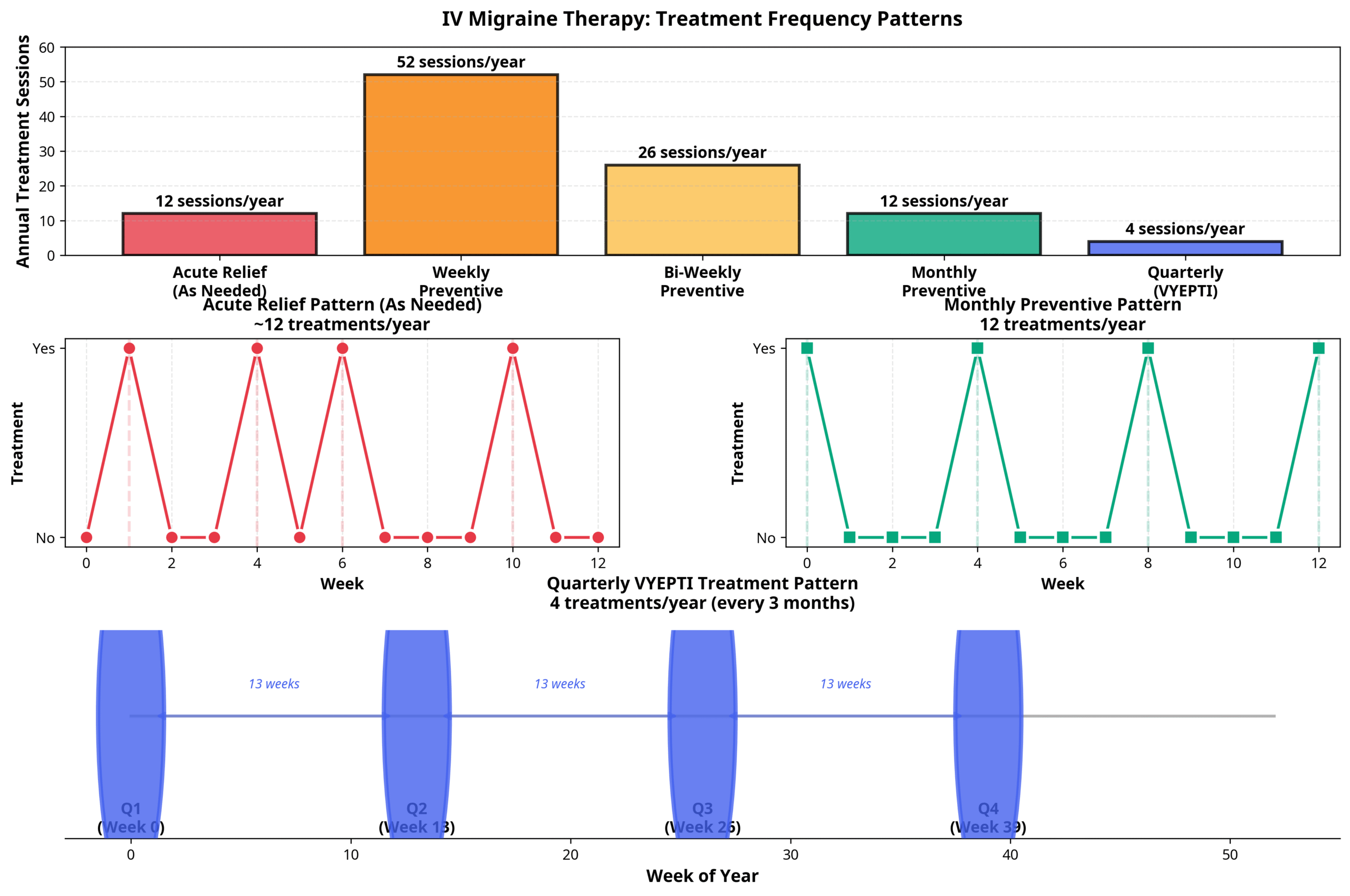
Most patients require 1-3 initial sessions to establish baseline improvement, followed by maintenance therapy tailored to their specific migraine pattern and severity.
Are the Results Long Lasting or Is Maintenance Needed?
IV headache infusion treatments remain effective for as long as one month after treatment. Patients treated with eptinezumab report high overall satisfaction with its effectiveness for chronic migraine management. The treatment demonstrates sustained ability to impact migraine symptomology positively.
Maintenance requirements vary by treatment approach:
- Single infusions provide relief lasting 2-4 weeks
- Preventive protocols maintain effectiveness with quarterly dosing
- Acute treatment effects persist for several weeks post-infusion
Patient satisfaction data reveals high approval ratings for long-term effectiveness, particularly among those receiving regular preventive infusions. The sustained benefits allow many patients to reduce their reliance on oral medications between treatments.
These outcome patterns demonstrate that IV therapy offers both immediate relief and extended benefits, making it a valuable option for comprehensive migraine management through The Drip IV Infusion’s specialized treatment protocols.
How Should You Approach IV Therapy for Migraine with The Drip IV Infusion?
IV therapy for migraine at The Drip IV Infusion combines targeted nutrient delivery with personalized treatment protocols. The approach focuses on rapid symptom relief through direct bloodstream administration while addressing individual migraine patterns and triggers.
Can The Drip IV Infusion Customize IV Therapy for Individual Migraine Needs?
The Drip IV Infusion customizes IV therapy for individual migraine needs through personalized formulation protocols. Their Migraine Cocktail IV delivers vitamins and pain-relief medications directly to the bloodstream for rapid absorption. The treatment includes High Dose Vitamin C therapy for immune resilience, inflammation support, and overall wellness boost. Customization occurs through adjusting vitamin concentrations, selecting specific anti-inflammatory agents, and modifying hydration volumes based on patient history. The direct bloodstream delivery bypasses digestive limitations, achieving therapeutic levels within 15-45 minutes.
What Are the Key Takeaways About IV Therapy for Migraine We Covered?
The key takeaways about IV therapy for migraine include rapid relief onset, customizable formulations, and sustained benefits. Treatment delivers 15-45 minute relief onset through direct bloodstream administration of magnesium, B vitamins, and anti-inflammatory medications. Success rates reach 74-86% for pain reduction according to clinical data. Personalized protocols at The Drip IV Infusion combine hydration, vitamins, and targeted medications for individual migraine patterns. Treatment frequency varies from acute single sessions to quarterly preventive infusions, with effects lasting up to one month. The therapy serves patients seeking alternatives to oral medications or experiencing medication-refractory migraines.
